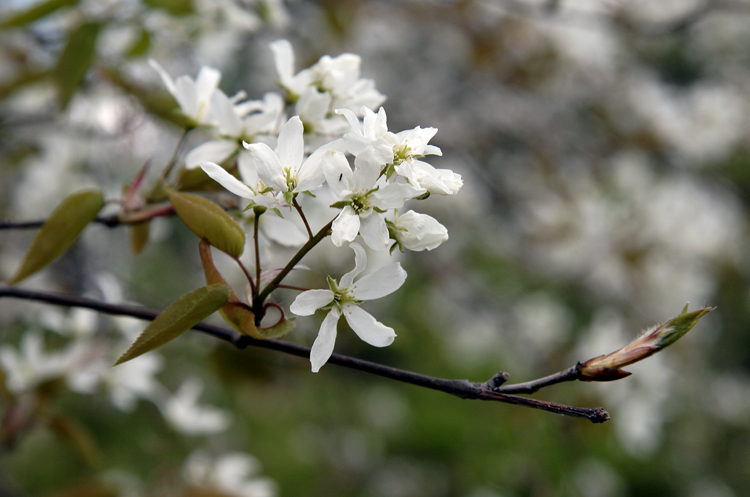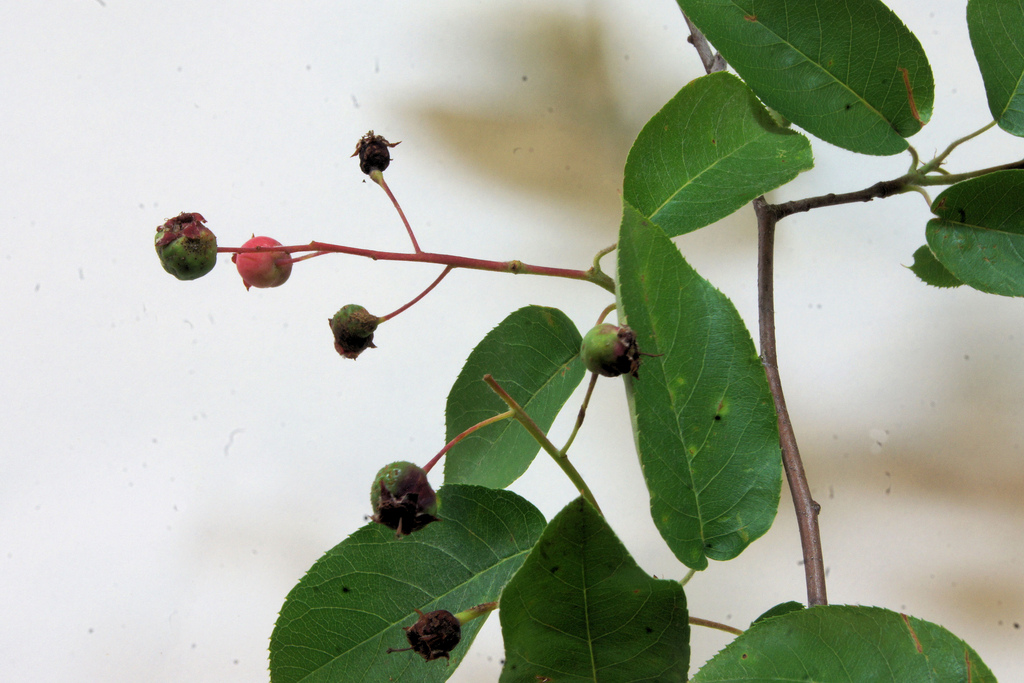Common Serviceberry
(Amelanchier arborea [Michx. f.] Fernald)
Description
The common serviceberry belongs to the rose family (Rosaceae)¹. It can grow to be up to 40 feet tall (12 meters) but can occasionally reach heights as tall as 66 feet (20 meters)¹. The trunk of the common serviceberry is typically around 6-16 inches (15-40 cm) in diameter¹. The bark is smooth and gray, and the buds of the common serviceberry are slender with a pointed tip, usually with more than two scales visible¹. The leaves are oval-shaped, about 1 ½ – 3 ¼ inches (4-8 cm) long and 1-2 inches (2.5–4 cm) wide, with pointed tips and finely serrated edges¹. The leaves of the common serviceberry can present in a few different colors, including orange-yellow, pink, or red¹. The common serviceberry has flowers that are up to 1 inch (15–25 mm) in diameter, with 5 white petals that emerge in early spring. These flowers are produced in multiples of 4-10 on pendulous racemes¹ . In the northern part of its range, the common serviceberry flowers at the same time its leaves emerge in April and May². Fruits are produced in June and July². In southern parts of its range, the common serviceberry flowers in March and produces fruit from June through August². The fruit which grows on the common serviceberry is a reddish-purple pome, resembling a small apple in shape².

Common serviceberry in flower. @G. Rembert, 2005. CalPhotos13

Common serviceberry leaves and fruit. @ B. Harms, 2012. Maryland Plant Atlas12.
Distribution
The common serviceberry is distributed from the southern tip of Newfoundland, Canada, to the northern tip of the Florida Panhandle, and west toward southern Ontario and Quebec, eastern Kansas, the eastern edge of Nebraska, and southern Mississippi and Alabama². North of Virginia, it is found along the Atlantic coast, but grows inland in regions south of Virginia². In total, the common serviceberry is native to 40 states and provinces across North America². This species grows well in acidic, moist and well-drained soils but can grow in a variety of habitats, including swampy lowlands, dry woods, sandy bluffs, rocky ridges, forest edges, and open woodlands and fields 3,4. Common serviceberry can be found to grow throughout Maryland12. Historically, the bloom of the serviceberry’s white flowers along the water’s edges signaled the beginning of fishing season for Atlantic shad fish7.

Distribution of common serviceberry. Wickimedia Commons 9.
Wildlife Importance
The consumption of the common serviceberry fruit is very popular with over 40 bird species, including the Eastern Bluebird and the Baltimore Oriole, and with several mammals such as squirrels, chipmunks, mice, voles, and foxes4,6. Some larger mammals, like moose, elk, and black bears will eat the leaves and twigs of this tree species7. In the spring, the common serviceberry blossoms entice beneficial insects, such as bees and butterflies, which provide the pollination services7. Since the common serviceberry are early bloomers, they are a very important source of food for many insects emerging from a chilly winter7. Some bird species, such as robins and cardinals, are known to nest in its branches7. Additionally, serviceberries are integral plants for the nesting of certain butterfly larvae, like tiger, viceroy, and admiral butterflies7.
Economic Importance
The common serviceberry is generally not large enough for saw timber, but it is often utilized for pulpwood4. The wood of the common serviceberry is extremely durable and can hold a polish, so it is occasionally made into tool handles4. Common serviceberry fruit can be enjoyed by humans as is or by baking it into pastries, puddings, and pies5.
Threats
The common serviceberry may be infected by many of the diseases common to plants in the Rosaceae family, though damage to the plant is mostly cosmetic8. Diseases that may infect the common serviceberry can consist of leaf spot, rust, or powdery mildew8. Pests that eat away at the bark of the tree include Japanese beetles, spider mites, aphids, and leaf miners3,4. Additionally, the bark of the common serviceberry is very thin and can be easily damaged by machinery8. Environmental damage such as drowning and edema may occur if the soil where this species is growing becomes too water-saturated, leading to rotted roots and bark and blisters on leaves4.
Interesting Facts
- There are several different common names for the common serviceberry, depending on location: downy serviceberry, juneberry, saskatoon, shadblow, shadbush, sugarplum10.
- Native Americans belonging to the Cree tribe have praised this species for its effectiveness in their manufacturing of bows4.
- The common serviceberry is related to the crabapple, cherry, plum, and peach trees, which are all members of the Rosaceae family11.
- Serviceberry fruit has a sugar content of 20% and are sweeter than blueberries and raspberries7.
References
- Trees of Wisconsin: Amelanchier Arborea, Downy Juneberry
- Honey Plants, Amelanchier arborea.
- Missouri Botanical Garden: Amelanchier arborea
- Nesom, Guy. “Downy Serviceberry .” Plant Guide, USDA- Natural Resources Conservation Service , 2006,Serviceberry:
- Backyard Forager–Serviceberry: The most delicious fruit you aren’t eating
- “Birds Attracted to Serviceberry.” Exploring Birds, 2016,
- “Serviceberries.” Canadian Wildlife Federation, 2021,
- Sheahan, C.M. “Canadian Serviceberry .” Plant Guide, USDA- Natural Resources Conservation Service , 2015,
- Wickimedia commons: Amelanchier arborea
- North Carolina State Extension: Amelanchier arborea
- Chase, Nan K. “The Amazing Serviceberry.” Mother Earth News, 2012, www.motherearthnews.com/real-food/the-amazing-serviceberry.
- Maryland Plant Atlas–Amelanchier arborea
- CalPhotos–Amelanchier arborea
Contributed by E. Thomas
